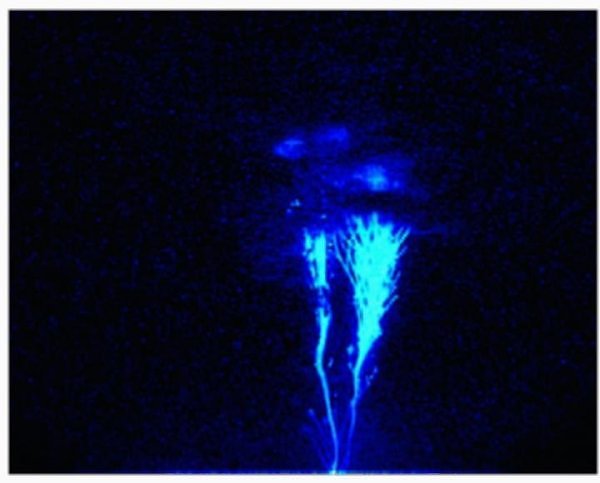
PROSPERO:
Hast thou, spirit,
Perform'd to point the tempest that I bade thee?
ARIEL:
To every article.
I boarded the king's ship; now on the beak,
Now in the waist, the deck, in every cabin,
I flamed amazement: sometime I'ld divide,
And burn in many places; on the topmast,
The yards and bowsprit, would I flame distinctly,
Then meet and join.
—Act I, Scene II, The Tempest
Shakespeare's The Tempest (c. 1623)
And just when I thought I had about covered everything I wanted to in the Severe Weather department I found out that lots of things go on in the upper atmosphere that man knows about or understands and that what we see is only the tip of the inverted iceberg and that, however strong or violent the phenomena are on the planet's surface, a lot is happening above the cloud level that, literally speaking, meets the eye

At the height of the Cold War, as the Dr Strangeloves of the world initiated nuclear tests in the upper atmosphere, launching the first satellites and sending their first men, women, monkeys and dogs into space, scientists were beginning to realise that a lot more goes on up there than they imagined.
The Van Allen belts had been discovered, and the impact of solar radiation was better understood, but knowledge of upper atmospheric meteorological phenomena – what really happens above thunderstorms – was a young science, with scientists only just advancing theories that what happens below thunderstorms may also happen above them as well, as late as the 1920s.
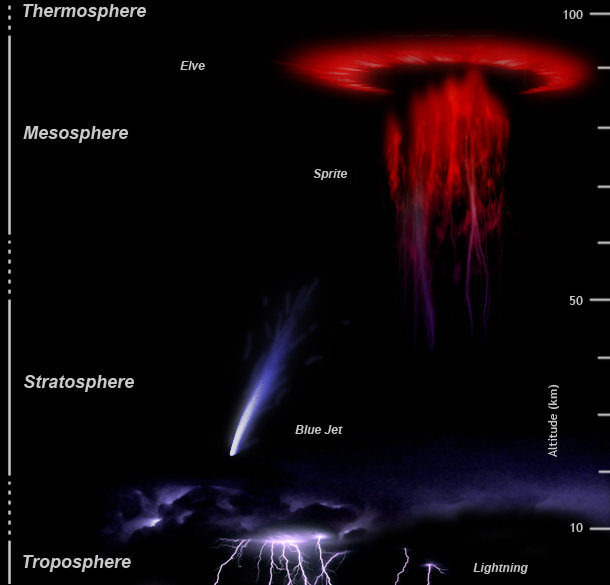
|
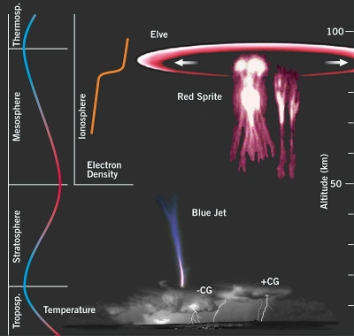
|
| Varying upper-atmospheric electrical phenomena |
With the advent of flight, and especially high-altitude flight, tales of electrical phenomena occurring while aviators and pilots traversed thunderstorms started circulating. The tales of fireballs dancing around planes and lightning piercing planes, leaving flight crews amazed and dumbfounded that they were unscathed, got scientists nodding their heads in confirmation. The phenomenon, already an established fact, known to mariners since ancient times as "St Elmo's fire", took on a new aerial dimension.
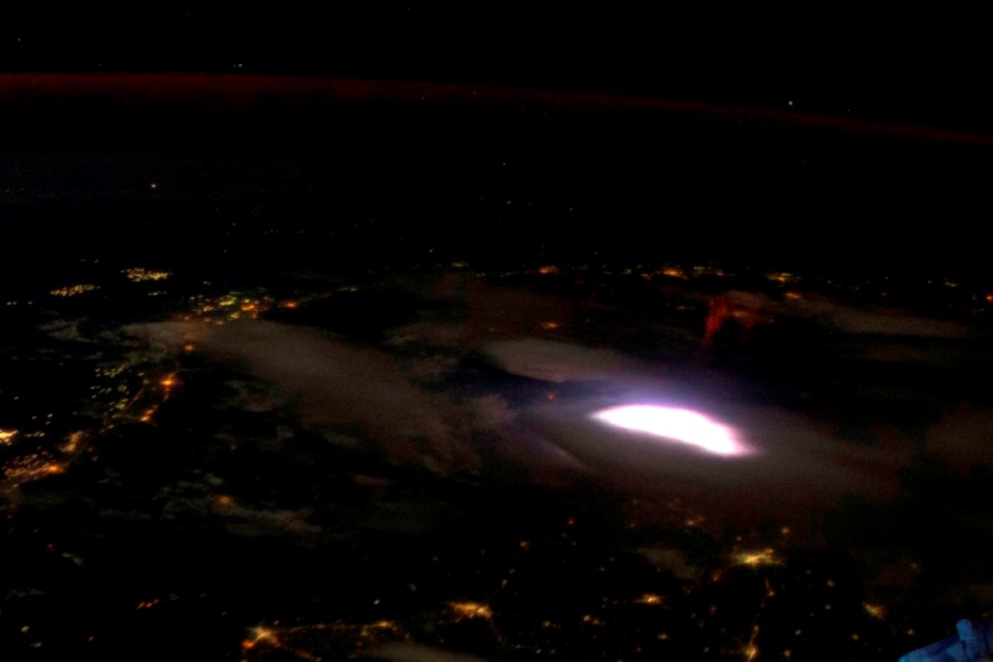 An exceptional photo of a Red Sprite appearing just about and to the right of the lightening - Courtesy of the NASA
An exceptional photo of a Red Sprite appearing just about and to the right of the lightening - Courtesy of the NASA
Having established the existence of St Elmo's fire in the upper atmosphere, with high-altitude flight and space exploration, scientists started registering the existence of other elements of more inconceivable power and began studying the effects and side effects of other known elements, such as the one "finding" that upward-directed upper atmospheric lightning actually serves a purpose, notably that of counteracting the effects of solar radiation and, according to NASA scientists, by creating a "safe zone" in the Van Allen radiation belts that surround the earth, this safety zone is known as the "Van Allen Belt slot".

Van Allen belts
With the improvement in technology, plus the acceleration in the number of space flights, meant the occasions to see and record upper atmospheric phenomena multiplied, and the films and photos the astronauts and satellites took of thunderstorms and other, at the time, more inexplicable phenomena were being viewed by everyone around the world. However, it's worth noting that in spite of all the possible advances made by science in the last 80 years, the first colour photo of one phenomenon called "Red Sprite" was only taken in the early 1990s.
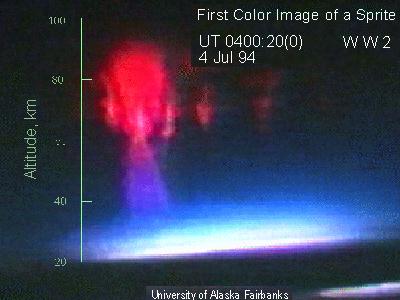
Red Sprite
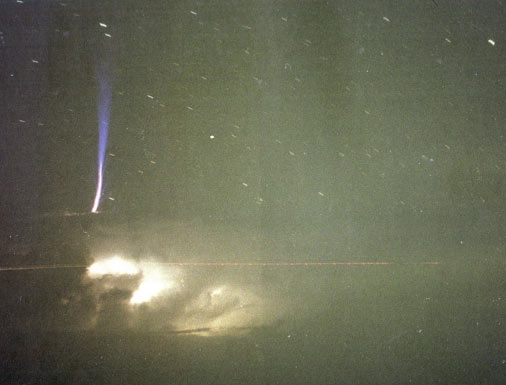
- Red Sprites are large but weak luminous flashes that appear directly above an active thunderstorm system and are coincident with powerful positive cloud-to-ground lightning strokes.Their spatial structures range from small single or multiple vertically elongated spots to bright groupings which extend from above the cloud tops to altitudes up to almost 60 miles (about 95 km). Sprites are predominantly red, and they usually last no more than a few milliseconds.
- The brightest region lies in the altitude range of 40 to 45 miles (about 65-75 km), above which there is often a faint red glow or wispy structure that extends to about 55 miles (90 km). Below the bright red region, blue tendril-like filamentary structures often extend downward to as low as 20 miles (30 km). Some events are loosely packed and may extend across horizontal distances of 30 miles (50 km) or more. Their shapes can be variously described as resembling jellyfish, carrots, or columns. Because of their low surface brightness, they have only been imaged at night (primarily with highly sensitive cameras).
- If a person's eyes are sufficiently night vision-adapted, they can actually detect Red Sprites without any enhanced visual aid. The first images of a sprite were accidentally obtained in 1989, although anecdotal reports of "rocket-like" and other optical emissions above thunderstorms go back more than a century. Early research reports for these events referred to them by a variety of names, including "upward lightning," "upward discharges," "cloud-to-stratosphere discharges," and "cloud-to-ionosphere discharges." Now they are simply referred to as 'sprites', a whimsical term that evokes a sense of their fleeting nature while at the same time remaining nonjudgmental about physical processes that have yet to be determined.
- Blue Jets are a second high-altitude optical phenomenon, distinct from sprites and first documented in 1994 (although pilots had earlier reported similar sightings). Blue jets are optical ejections from the top of the electrically active core regions of thunderstorms but are not directly associated with cloud-to-ground lightning. Following their emergence from the top of the thundercloud, they typically propagate upward in narrow cones of about 15 degrees, fanning out and disappearing at heights of about 25-30 miles (40-50 km) with a lifetime of a couple of tenths of a second.
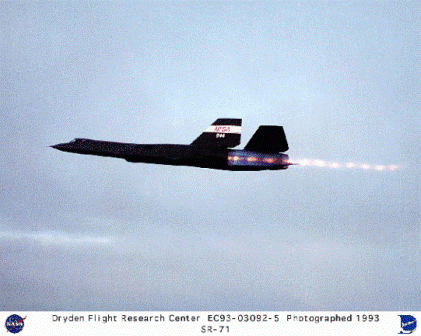
...talking of jets... this one regularly flew up in the ozone layer of stratosphere

As mentioned at the start a lot goes on in earth's upper atmosphere that man can visually measure and the more the scientists started to look, the more they refined their research methods the more they found, such as:
- TROLLs(Transient Red Optical Luminous Lineament) occur after an especially strong sprite, down in the lowest tendrils near the cloud tops. Early recordings showed them as red spots with faint red tails, rising much like blue jets. Faster cameras show trolls to be a rapid series of events. Each event starts with a red glow that forms in a sprite tendril, then "drains" downward. Each following event starts higher so that the series looks like an upward blur in slower videos. This is a typical pattern in science: looking at the same old thing with better instruments always reveals something new and unexpected.
- Gnomesare small, very brief white spikes of light that point upward from the top of a large thundercloud's anvil top, specifically the "overshoot dome" caused as strong updrafts push rising moist air slightly above the anvil. They appear about 150 meters wide and about a kilometre high, and they last a few microseconds. Gnomes are possibly just a different manifestation of Blue Starters but appear with a more compact shape above convective domes
- Pixies are so small that they appear as points, making them less than 100 m across. In the video that first documented them, they appear scattered across the overshoot dome, flashing seemingly at random. Pixies and Gnomes appear to be a pure white colour, like ordinary lightning, and they do not accompany lightning strokes
- Pixies are smaller, less than 100m wide. On video, they appear to be scattered across the top of the cloud, flashing seemingly at random.
- Pixies are pinpoints of light, lasting less than 16 milliseconds, on the surface of convective domes that produced gnomes
- Elves are rapidly expanding (up to 300 miles across) disc-shaped regions of luminosity, lasting less than a thousandth of a second, which occur high above energetic cloud-to-ground lightning of positive or negative polarity.
- Elves most likely result when an energetic electromagnetic pulse (EMP) propagates into the ionosphere. Though they can be accompanied by Sprites, the causative mechanism is of an entirely different nature..
- Thought to exist in 1991 and discovered with a low-light video camera aboard the Space Shuttle in 1992, Elves got their name as an acronym for Emission of Light and Very Low Frequency perturbations due to Electromagnetic Pulse Sources.
- Blue Starters differ from Blue Jets in that they are brighter but shorter (reaching to only about 12 miles altitude). These were reported to occur over regions where large hailstones were falling.
- Upward lightning is similar to a conventional lightning bolt, generally rather straight and may be tilted off the vertical axis, but does not flicker like cloud-to-ground flashes. Lasts one, two and even 5 seconds with a yellow or white lightning channel, maybe with blue flames above.
- Sprite Halos were mistaken for Elves until 1999. They diffuse disc-shaped glows that apparently precede Sprites and propagate downward from about 50 miles to 40 miles (85 to 70 km) altitude and last about a millisecond.
- First documented in July 2002, Gigantic Jet are similar to carrot-shaped Red Sprites in spatial extent but propagate upward from the core of oceanic thunderstorms and are not directly associated with cloud-to-ground lightning.
- (Transient Ionospheric Glow Emission in Red). Usually, Sprites and Elves emerge within a few milliseconds of the nearest lightning strike, but TIGER takes 250 milliseconds to leap into view after a lightning strike, suggesting a distinction between Sprites, Elves and TIGERs.
With e discovery of these phenomena – what else remains to be discovered? The fact is that if it took mankind so long to discover the above elements, it's because the technology was limited or lacking. Phenomena such as 'Elves" aren't visible to the human eye and can only be detected by radar or radio.' Other phenomena, like Pixies, are fleeting and only perceptible from the corner of the eye and certain need technology so advanced to capture them it leaves you asking if there is no limit to what mankind will discover that goes on in the sky above... and then there are the conspiracy theorists who are convinced there's more to it than the scientists can rationalise.
Definitions reproduced with the kind courtesy of the original authors, such as:
http://www.newscientist.com/article/dn6897
http://spaceweathergallery.com/Sprites
and... Wikipedia.
© Nicholas Richards 11/2010, updated 12/2016




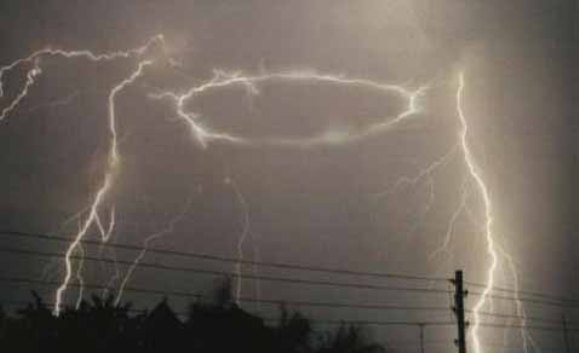

![]()


